Animals that are vivid, primary yellow — not tawny or orange-yellow or any of those tones and shades — are somewhat uncommon. When they are found, their bright yellow coloration adds to their beauty.

Bright yellow animals have their color not because humans find it attractive, but to warn predators that they are poisonous, attract mates, or even camouflage.
The yellow animals here are adults, since so many chicks are born with yellow down that they lose over time, and other juvenile forms may change color as they mature.
These are mostly wild since pets such as the famous yellow boa constrictor and domestic canaries are bred to achieve their shades of brilliant yellow.
Here are 10 of the most beautiful yellow animals:
#10 Most Beautiful Yellow Animal: Golden Poison Dart Frog

©Thorsten Spoerlein/Shutterstock.com
This little frog is found only in the rainforests on the Colombian coast and is now endangered. Its color ranges from a pale lemon yellow to a lush gold, and it has huge black eyes.
This makes the poison dart frog look innocuous, and it is docile, intelligent, and gregarious as well as pretty. Still, it comes by its scientific name, Phyllobates terribilis honestly.
The frog is so poisonous that it is dangerous to even pick it up with bare hands. Its skin is full of alkaloid toxins and just one milligram of it can kill as many as 20 humans.
The frog doesn’t make the toxin itself but gets it from eating insects that contain the poison. Still, even if the golden poison dart frog is kept as a pet and fed non-toxic insects, the toxins in its skin can last for years.
In fact, the golden poison frog is considered one of the most toxic animals alive today. A single frog measuring two inches has enough venom to kill at least ten grown men.
The poison dart frogs are fed crickets when kept in Zoos and can live up to 10 years in captivity. Although yellow poison dart frogs aren’t endangered, some species are such as the Blue Poison Dart Frog.
#9 Most Beautiful Yellow Animal: Eurasian Golden Oriole

©iStock.com/phototrip
The male of this bird of Europe, central and western Asia, and northern India is known for its vividly yellow head and body and black wings. The female, as is usual in such brilliantly colored birds, is duller.
It’s a shy bird, and even the male is fairly well camouflaged as he searches through the tops of trees for insects and fruit.
Though it has a harsh, blue jay-like call, the song of the Eurasian golden oriole is memorably sweet. These 8.5-inch long orioles often wait until they are two or three years old to breed.
Eurasian Golden Oriole lives all year round in forests and both males and females spend most of their time perched in tall trees where they build nests with woven grasses in a bowl-like shape.
Golden Orioles feed on insects, nectar, and fruits found in their environment. Occasionally, these birds will also eat southern flying lizards.
These birds can be found in most of India, however, in the winter months, they migrate down to the peninsula. Not only that, but they can also travel at speeds up to 26 miles per hour.
#8Most Beautiful Yellow Animal: Misumena vatia

©Tobias Hauke/Shutterstock.com
Crab spiders are also called flower spiders, and they can change color, although slowly, to match that of the flower they wait on.
In the case of the spider Misumena vatia, the flower is often goldenrod. Like other crab spiders, M. vatia has a wide body with legs that are held crabwise, which allows it to walk sideways.
Females are much larger than males and can be 0.39 inches long as opposed to male’s 0.16 inches. Crab spiders produce powerful venom for their size and so can take insects and other arthropods that are much bigger than they are.
M. vatia is found in North America and Europe and can be such a bright yellow animal that its nickname is “the banana spider.”
The Banana Spider is actually one of the world’s largest web-spinning spiders and a female can have a leg span of 4.7 inches long! This sparkle is often found camouflaged on daisies and other white and yellow flowers.
Her web can measure around 3 feet and the silk can be stronger than Kevlar which is used to make bulletproof vests.
Misumena vatia‘s feed on common insects, although they can eat prey much larger than themselves. However, they are harmless to humans.
#7Most Beautiful Yellow Animal: Orange-barred Sulphur Butterfly
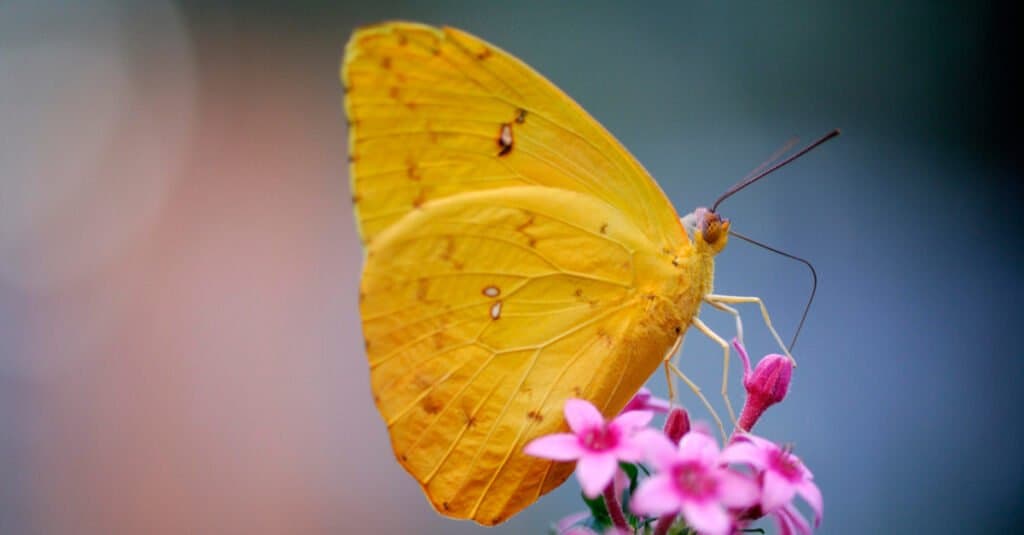
©imageBROKER.com/Shutterstock.com
Also called the yellow apricot, males of this butterfly are uniformly bright yellow above, with darker yellow triangles on the forewings and darker shadings on the edges of their hind wings.
Below, they are salmon-colored or shades of purple.
The females are a bit more variegated, with reddish spots on their forewings and yellow fading to rust-red on their hindwings. When they are a caterpillar, they are typically green with faint hints of yellow.
They can be found in lowland places like gardens, forest edges, and parks.
The butterfly has a 2.25 to 3.25-inch wingspan and is found in Brazil northward into Central America and southern Florida.
Not only is this butterfly stunning, but this butterflies size provides amazing speeds and control while in flight.
Butterflies such as these suck the nectar out of a tube-like tongue and taste with their feet. The Orange-barred Sulphur Butterfly eats nectar from alfalfa, clover, milkweeds, and sunflowers.
#6Most Beautiful Yellow Animal: Eyelash Viper
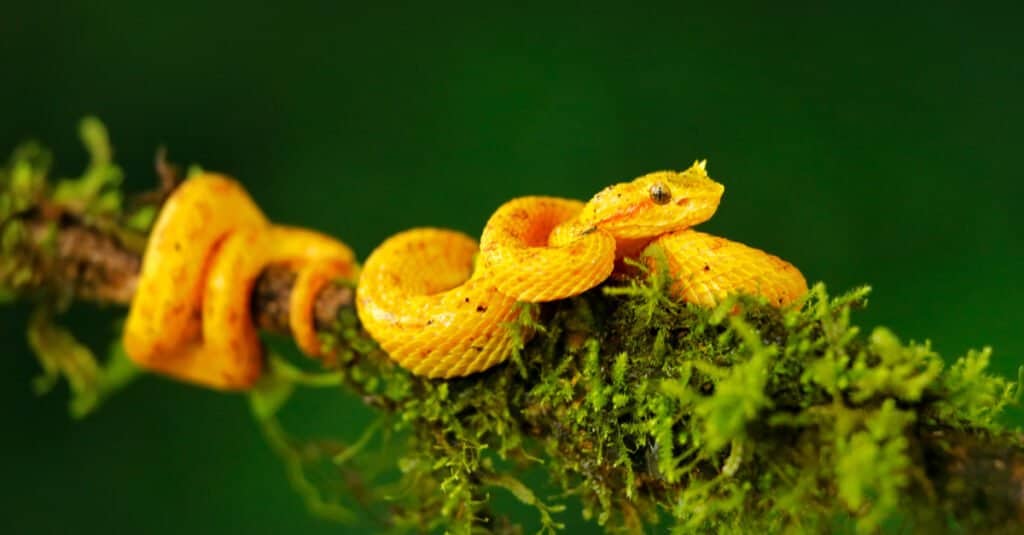
©Ondrej Prosicky/Shutterstock.com
This South and Central American snake gets its name because it has scales over its eyes that look like eyelashes.
This is also believed to help camouflage the snake as it moves among the trees where it lives. Its eyes are large and have vertical pupils like a cat’s.
The eyelash viper is famous for the many color variations among wild individuals, and yellow is one of them. Both males and females can be a bright shade of yellow.
The colorful snake is often found in zoos, and though it is a pit viper and is seriously venomous, it’s even kept as a pet and bred to make its brilliant colors even more brilliant.
This particular species of viper attacks quickly and injects its hemotoxic venom and then waits for its prey to die. They have long fangs and the bite is very painful and often deadly.
Their natural habitat consists of sea-level, moist forests. The snake isn’t large and usually grows to only 32 inches long, with females being longer than males. Both males and females can live up to 10 years.
Eyelash vipers also don’t lay eggs, they are ovoviviparous which means their eggs are fertilized and incubate inside the female snake and she gives birth to live young.
#5Most Beautiful Yellow Animal: American Goldfinch
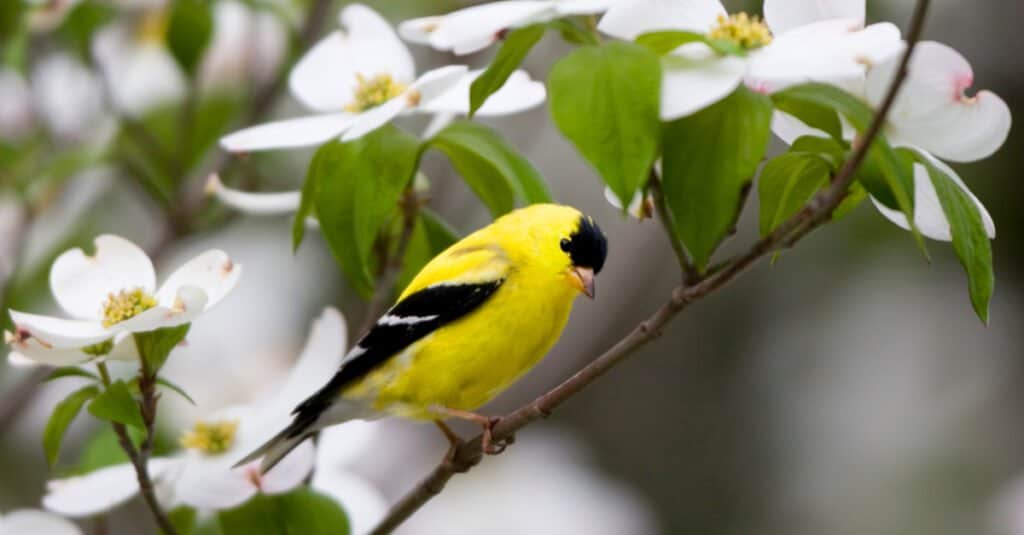
©Danita Delimont/Shutterstock.com
Like the Eurasian golden oriole, the American goldfinch male has a bright yellow body and black wings, though it is a smaller and more compact bird found in North America.
The goldfinch’s natural habitats are weedy fields and floodplains. The Goldfinch is most active during the day and has incredible flying skills. They fly in wavelike patterns when flying long distances.
It also has a black spot on its head. This, it must be said, is its summer breeding plumage, for in winter its plumage is more olive green. The female is yellowish-brown.
The American goldfinch has a conical beak that is made for cracking and eating seeds, though it’s not above raiding the vegetable garden for leafy greens.
It is migratory, travels in huge flocks, and adores feeding stations in backyards. It’s also attracted to land that’s been cleared of trees. There are four American goldfinch subspecies:
- Spinus tristis tristis
- Spinus tristis pallidus
- Spinus tristis jewetti
- Spinus tristis salicamans
American Goldfinches are one of the strictest vegetarians among all birds. Their entire diet consists of vegetables and will only eat insects by accident.
Goldfinches molt twice a year and are late breeders. This means that instead of breeding in the Spring, they are likely to mate in late Summer.
A male Goldfinch will mark his domain by perching around a perimeter of his territory as well as circle and perform flight displays.
#4Most Beautiful Yellow Animal: Swallow-tailed Moth
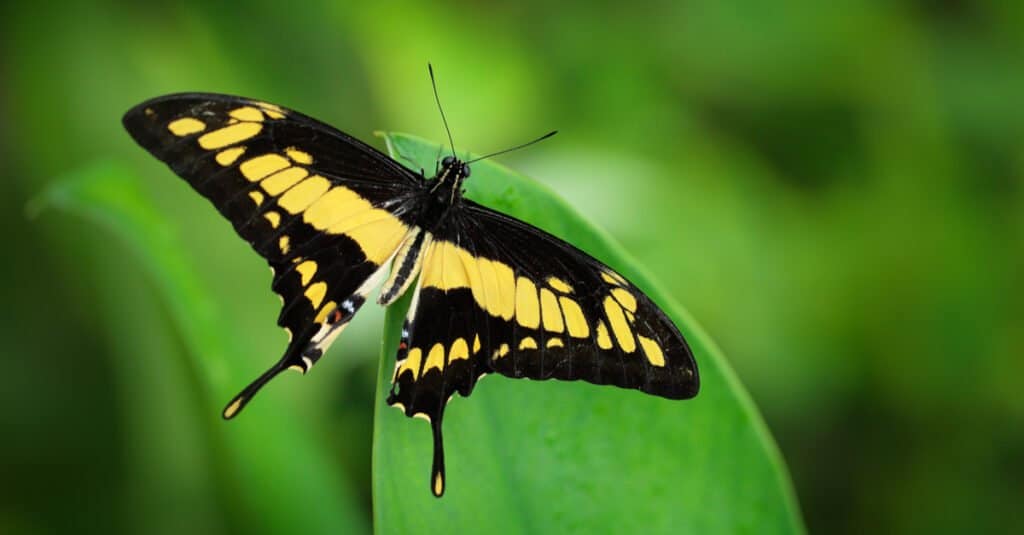
©Ondrej Prosicky/Shutterstock.com
This beautiful moth of the palest yellow is found in Europe and the temperate areas of Asia.
It has tiny tails on its hind wings and darker yellow lines running across both pairs of wings.
It is often mistaken for a butterfly if it’s seen during the day, but it has a robust, hairy body associated with moths.
It is active at night, drawn irresistibly to artificial light, and seen only briefly during the summer months. The caterpillar is a looper that feeds on hawthorn and ivy and overwinters.
Swallow-tailed Moths grow less vibrant with age. The older the moth, the whiter it may appear with two dark lines crossing the wings.
These moths are often found in wooded areas, bogs, and gardens. Adults are often skittish and will attempt to flee at any sign of movement or danger. They feed on larvae on trees and shrubs.
#3Most Beautiful Yellow Animal: 22-spot Ladybird
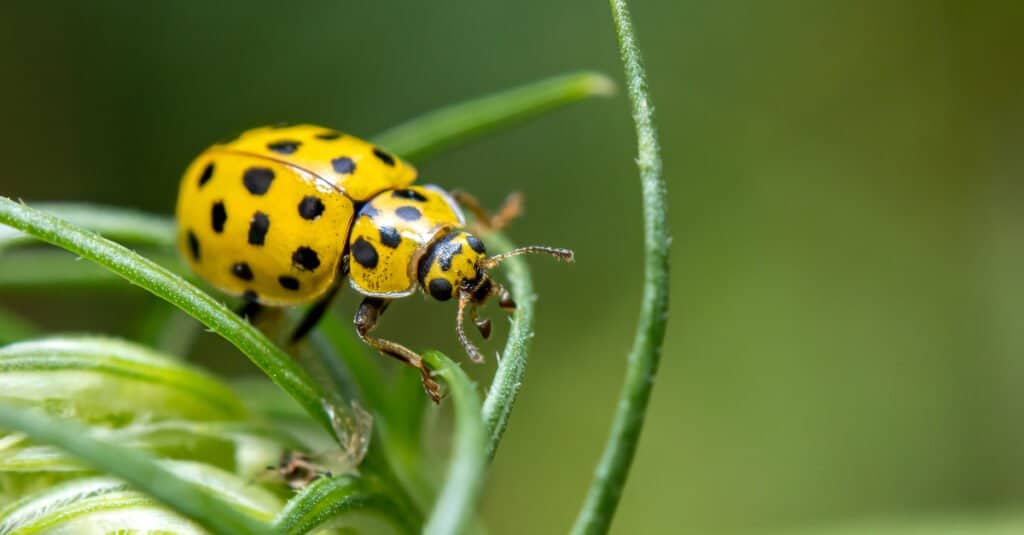
©marcinswiostek/Shutterstock.com
The person who coined the phrase “cute as a bug” must have been thinking of this tiny beetle.
Found in Europe, this 0.12- to 0.20-inch long insect is bright yellow, and its elytra, which are the hard wings over its hind wings have exactly 22 black dots.
The pronotum, a shield-like structure that covers part of its thorax, is also yellow or sometimes white and has five dots.
The 22-spot ladybird is found in Europe from the United Kingdom to Ukraine and south to Iran and Turkey.
It’s best seen from spring to fall and lives in low shrubs and other plants. Interestingly, the 22-spot ladybird is not a voracious predator of insect pests like its ladybug cousins but eats mildew. Its larvae are also yellow and spotted.
The 22-spot Ladybird is found in a wide range of places, although it favors grasslands, woodland edges, towns, and even some gardens.
#2Most Beautiful Yellow Animal: Banana Slug

©Meyta/Shutterstock.com
Its frank resemblance to a banana in both shape and color gives this giant slug its name. One type of this slug, the Pacific banana slug, can grow close to 10 inches in length and weigh a quarter of a pound.
Like other land slugs and snails, banana slugs have a radula, which is rather like a tongue equipped with rows of tiny teeth, and four tentacles.
The larger pair is on top of the head and serves as eyes, and the second pair, which are found beneath the first, pick up chemical trails. This animal can regenerate its tentacles if it loses them. Banana slugs are hermaphrodites, and a couple fertilizes the eggs of the other.
This slug is famously found in the temperate rainforests of the Pacific Coast of North America, from Alaska down to California.
The high humidity found in these forests is a must for these creatures, who are ever at risk of drying out. The slug eats detritus, and their excretions make for good fertilizer.
The slug is in turn eaten by a variety of animals including snakes, raccoons, and moles. To keep the slime the slug secretes from numbing their mouths, predators roll it in the dirt first.
Banana slugs live from one to seven years and is native to dense, wet forests. These slugs are mostly found in Central California and even Alaska.
#1Most Beautiful Yellow Animal: Gold Lace Nudibranch
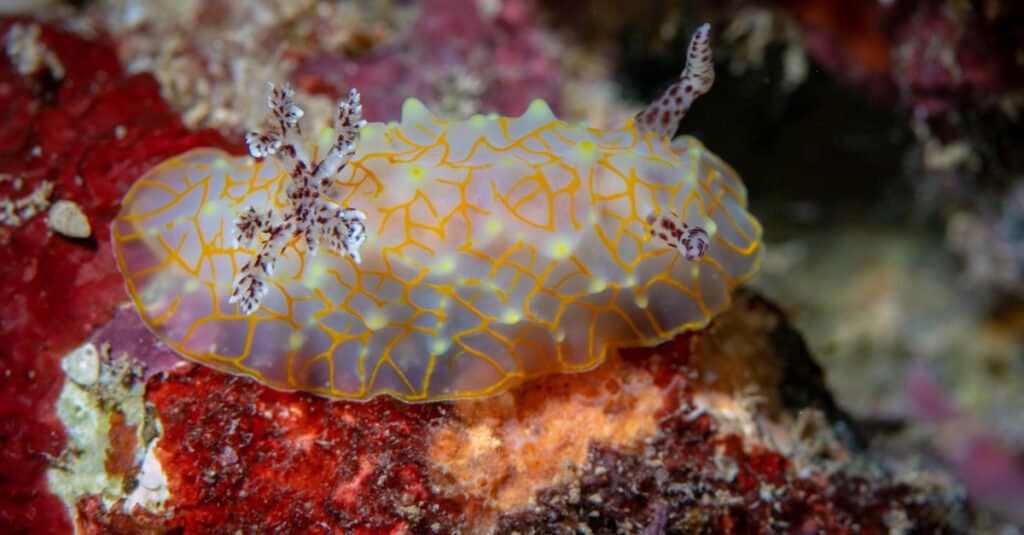
©RobJ808/Shutterstock.com
Found only in the warm waters off Hawaii, this nudibranch, or sea slug looks like a 2-inch long pillow covered with golden lace.
The lace is actually made up of golden lines with pale yellow tubercles. The mantle of the nudibranch also has a bright orange-yellow line, and its gills resemble black and white tree branches.
The rhinophores, which the animal uses to pick up chemical signals in the water much like a nose, are also white and covered with black speckles.
Like other “nudies,” the gold lace nudibranch is a carnivore and eats sponges, hydroids, and moss animals. It prefers to keep to the inside of caves and among rocks and doesn’t like to be seen traveling across open sand.
The gold lace nudibranch is a recent discovery. Although it’s pretty common around Hawaii, it wasn’t discovered until 1982.
The epithet of its scientific name, Halgerda terramtuentis means “looking at the earth with care” in honor of the folks at the Earthwatch Institute who helped identify it.
Summary of the 10 Most Beautiful Yellow Animals
| Name of Animal | Type of Animal | Habitat and Location |
|---|---|---|
| Gold Lace Nudibranch | Sea Slug (Mollusk) | Hawaii’s warm waters on rocks and the inside of caves. |
| Banana Slug | Slug (Mollusk) | Temperate rainforests of the Pacific Coast of North America. |
| 22-spot Ladybird | Beetle (Insect) | Low shrubs and other plants in grasslands, woodland edges, and gardens from the United Kingdom across Europe to Ukraine, Iran, and Turkey. |
| Swallow-tailed Moth | Moth (Insect) | Wooded areas, bogs, and gardens in Europe and the temperate areas of Asia. |
| American Goldfinch | Bird | Weedy fields and floodplains in North America. |
| Eyelash Viper | Pit Viper Snake | Sea-level, moist forests in South and Central America. |
| Orange-barred Sulphur Butterfly | Butterfly (Insect) | Gardens, forest edges, and parks in Brazil, Central America, and southern Florida. |
| Misumena vatia or “Banana Spider” | Web-spinning Crab Spider (Arachnid) | On flowers in North America and Europe. |
| Eurasian Golden Oriole | Bird | In forests in Europe, central and western Asia, and northern India. |
| Golden Poison Dart Frog | Frog (Amphibian) | Rainforests on the Columbian coast. |
The photo featured at the top of this post is © Ondrej Prosicky/Shutterstock.com
Thank you for reading! Have some feedback for us? Contact the AZ Animals editorial team.






